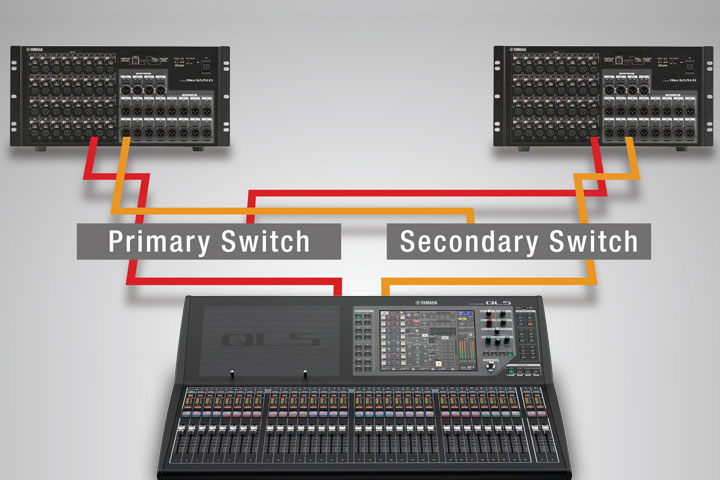Tech Focus: Digital Audio Networks, Part 1 — A Proliferating Presence in Sports Venues
Story Highlights
Digital audio networks have become the fastest-growing category in professional audio in recent years, and they are having an impact on sports venues. Although their rapid rise has given them a patina of high-tech novelty, the idea has been around for more than two decades.
Joe Patten, an associate at Boston-area consultancy Communications Design Associates, recalls the first audio network he specified for a sports venue: a CobraNet system for the Tennessee Titans’ new and then-named Adelphia Stadium in 1999. “At the time, it was rudimentary, but it was what we had. Today, we see some kind of advanced audio networking in virtually all new stadiums and for sound-system upgrades.”
He notes that problems particular to sports venues are solved by systems like the Dante/Symetrix DSP combination platform he usually specifies: long-distance cable runs for line-level audio signals and induction issues for voltages that cause induced line noise. In addition, he says, the cost savings and efficiencies that networking brings are significant: “[They’re] measureable [given] the amount of copper cabling we used to use.”
However, Patten says, A/V systems integrators aren’t necessarily enthusiastic about networked audio, because they either aren’t familiar with the concept or have had the wrong kind of experience with it. He notes that CobraNet, the first widely used networking platform, was dogged by latency and other performance issues.

Dante’s support for redundant connections on the network won’t stop the show. Redundant primary and secondary connections can be set up in a star-network configuration so that problems in any part of the network won’t interrupt the signal flow or bring the entire network down.
“CobraNet was the first kid on the block, and it served its purpose,” he says. “But it also may have put some people off of networked audio. Today, with platforms like Dante, the cost savings and efficiencies you get with networked audio vs. analog cabling are too considerable to not use it.”
Too Much Choice
If A/V integrators and consultants had too few platform choices 20 years ago, today, they may have too many, with close to a dozen protocols and standards-based platforms competing for market position. (See Tech Focus: Digital Audio Networks, Part 2.) Some of them are open standards: they allow components from various manufacturers to work on a network but have the potential for individual components to not always play well together. Others are proprietary: a closed ecosystem uses only components from a single vendor or its certified partners. The interoperability standard AES67 is intended to bridge the divide between open and proprietary, as well as proprietary and proprietary.
The most successful proprietary network so far is Audinate’s Dante, which has achieved a level of critical mass — reportedly close to 300 licensees make more than 700 compatible products, from amplifiers to mix consoles — that has prompted many observers to call it the de facto industry standard. Its presence in sports venues can likely be traced to the 2012 installation of a Dante network combined with three Symetrix SymNet Radius 12×8 processors at the Wells Fargo Center, home to the Philadelphia 76ers and the Philadelphia Flyers.
A source at Audinate estimates that there are about 40 Dante-enabled sports-venue installations globally, 15 in Europe, including Manchester City Stadium and the Regensburg Continental Arena. Most of the rest are in the U.S., including the Titans’ updated Nissan Stadium and the Pittsburgh Pirates’ PNC Park.
Many network suppliers are targeting sports venues. QSC, whose proprietary Q-Sys system is installed at Dynamo Stadium in Tbilisi, Georgia, and at the NFL Detroit Lions’ Ford Field, has a dedicated web page for sports. Yamaha, an early adopter of the Dante network, has done the same. Ravenna, championed by European audio manufacturers like Lawo, has gained significant traction at venues in Europe and the EMEA region.
Networked audio is quickly becoming the norm for sports-venue systems design and integration. According to Phil Wagner, president of Focusrite Novation, which markets the RedNet series of network interfaces installed in venues including the Dayton (OH) Dragons Minor League Baseball park and used for the halftime field sound for the Super Bowl, systems designers and integrators can’t ignore the cost savings that come from networked audio.
“Moving audio onto a fiber cable increases flexibility, because you can put microphones or speakers anywhere you can run a single cable to, and reduces cost, because you’re no longer running dozens or even hundreds of strands of copper anymore,” he explains. “And it improves the overall quality of the field audio, because the network is immune to the hums and buzzes and other artifacts of analog audio. Between Dante and AES67, the infrastructure is now here for affordable, reliable networked audio.”
